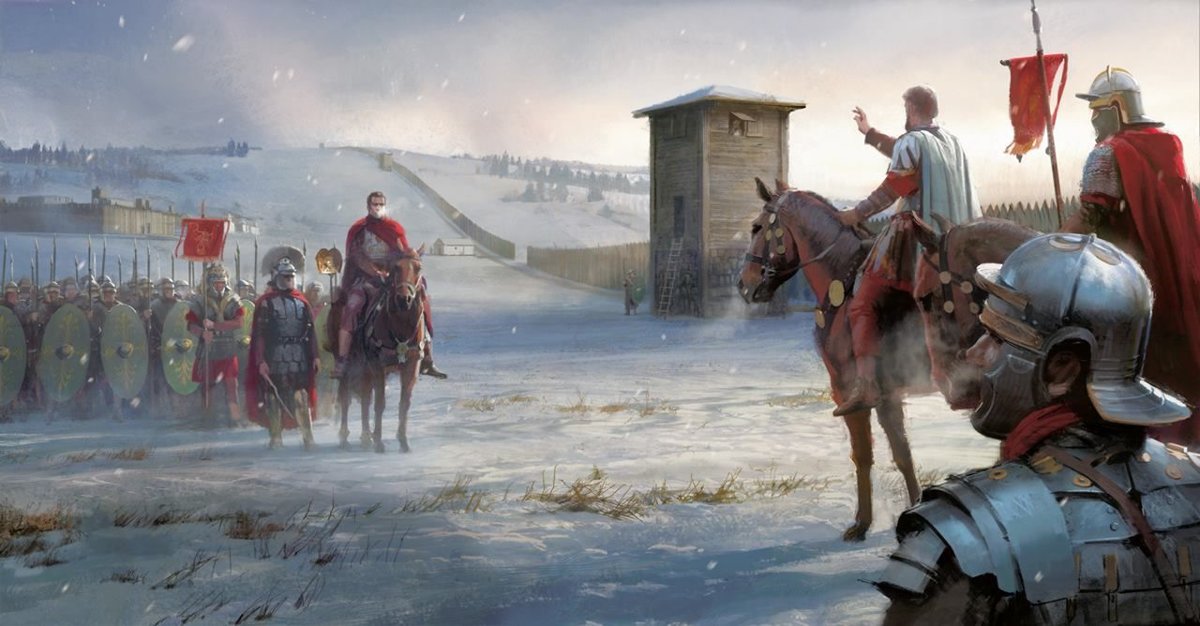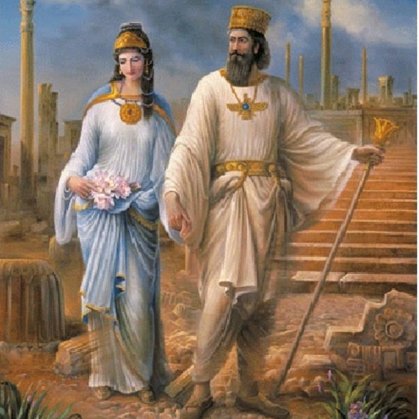PERSIAN EMPEROR CYRUS THE GREAT AND HIS EMPRESS CASSANDRA OF THE ACHAEMENID EMPIRE (600/ 576 – 530 BC).THE VICTORY OVER BABYLONIA EXPRESSED ALL THE FACETS OF THE POLICY OF CONCILIATION WHICH CYRUS HAD FOLLOWED UNTIL THEN.
 Emperor Cyrus the Great with his beloved Shahbanu, Empress Cassandane.Cyrus was preceded as king by his father Cambyses I, grandfather Cyrus I, and great-grandfather. Cyrus married Cassandane who was an Achaemenian and the daughter of Pharnaspes who bore him two sons, Cambyses II and Bardiya along with three daughters, Atossa, Artystone, and Roxane. Cyrus and Cassandane were known to love each other very much Cassandane said that she found it more bitter to leave Cyrus than to depart her life.The name "Cassandane" later evolved to "Cassandra" means: "Creation of Glory" in Old Persian .
Emperor Cyrus the Great with his beloved Shahbanu, Empress Cassandane.Cyrus was preceded as king by his father Cambyses I, grandfather Cyrus I, and great-grandfather. Cyrus married Cassandane who was an Achaemenian and the daughter of Pharnaspes who bore him two sons, Cambyses II and Bardiya along with three daughters, Atossa, Artystone, and Roxane. Cyrus and Cassandane were known to love each other very much Cassandane said that she found it more bitter to leave Cyrus than to depart her life.The name "Cassandane" later evolved to "Cassandra" means: "Creation of Glory" in Old Persian .
Cyrus the Great (ca.600 - 529 BCE) was a towering figure in the history of mankind. As the "father of the Iranian nation", he was the first world leader to be referred to as "The Great". Cyrus founded the first world empire - and the second Iranian dynastic empire (the Achaemenids) - after defeating the Median dynasty and uniting the Medes with the other major Iranian tribe, the Persians.In the Cyrus cylinder (see below), the great king declares his ancestry as a Persian king. The first leader of the Achaemenid dynasty was king Achaemenes of Anshan (ca.700BCE). He was succeeded by his son Teispes of Anshan and inscriptions indicate that when the latter died, two of his sons shared the throne: Cyrus I of Anshan and Ariaramnes of Persia. They were succeeded by their respective sons: Cambyses I and Arsames. Arsames was the ancestor of Darius the Great, while Cambyses was the father of Cyrus the Great. Mandane, Cyrus' mother, was the daughter of king Astyages, who was the last emperor of the Median dynastic empire (728-550BCE). Cyrus became king of Anshan after his father's death in 559BCE, and initially reigned as Median vassal king of the Persian tribes. He established his residence at Pasargadae in Pars province, the centre of the Pasargadae tribe, to which the Achaemenid clan belonged. Little is known of Cyrus' early life as the few known sources have been damaged or lost. According to the ancient historians, Astyages was told in a dream that his grandson, the baby Cyrus, would overthrow him. To avoid this he ordered that the baby be killed. However the official delegated with the task gave the baby to a shepherd instead. When Cyrus was ten years old, the deception was discovered by Astyages, but because of the boy's outstanding qualities he was allowed to live in exile with his mother. Cyrus then revolted against Astyages in 554BCE and in 550BCE the prophecy came true when Cyrus entered Ecbatana (modern-day Hamadan), effectively conquering the Median Empire. Upon his victory over his grandfather he founded a government for his new kingdom, incorporating both Median and Persian nobles as civilian officials. He thus began to build the first world empire.Cassandane Shahbanu was an Achaemenid Persian noblewoman, the daughter of Pharnaspes and the beloved wife of Cyrus the Great. She bore four children: Cambyses II (who succeeded his father and conquered Egypt), Smerdis (Bardiya) who also reigned as the king of Persia for a short time and a mighty daughter named Atusa. Princess Atusa later played an important role in Achaemenid royal house. Cyrus loved his Queen Cassandane dearly and when she died the entire empire observed a great mourning. Cyrus never recovered from the grief of losing her and stayed inactive for nearly a decade after her death. Behind every great man there’s a great woman and vice versa! There is a report in the chronicle of Nabonidus that, when "the king’s wife died," there was a longlasting public mourning in Persia along with all the twenty-five nations that were part of the empire. Queen Cassandane was buried in the tower called Zendaan-e Solaymaan at Pasargadae Persia. Her daughter Atossa later played an important role in the Achaemenid royal family, as she married Darius the Great and bore him the next Achaemenid king, Xerxes I. Atossa had a "great authority" in the Achaemenid royal house and her marriage with Darius I is likely due to her power, influence and the fact that she was a direct descendant of Cyrus. When Cassandane died, all the nations of Cyrus' Persian empire observed "a great mourning".
 The Battle of Thymbra was the decisive battle in the war between Croesus of the Lydian Kingdom and Cyrus the Great of the Achaemenid Empire. Cyrus, having pursued Croesus into Lydia following the drawn Battle of Pteria, met the remains of Croesus' partly disbanded army in battle on the plain north of Sardis in December, 547 BC. Even though Croesus' army was reinforced with many new men, Cyrus utterly defeated it, despite being outnumbered more or less 2:1. This proved decisive, and after the 14-day Siege of Sardis, the city and possibly its king fell, and Lydia was conquered by the Persians.
The Battle of Thymbra was the decisive battle in the war between Croesus of the Lydian Kingdom and Cyrus the Great of the Achaemenid Empire. Cyrus, having pursued Croesus into Lydia following the drawn Battle of Pteria, met the remains of Croesus' partly disbanded army in battle on the plain north of Sardis in December, 547 BC. Even though Croesus' army was reinforced with many new men, Cyrus utterly defeated it, despite being outnumbered more or less 2:1. This proved decisive, and after the 14-day Siege of Sardis, the city and possibly its king fell, and Lydia was conquered by the Persians.Cyrus II of Persia commonly known as Cyrus the Great and also called Cyrus the Elder by the Greeks, was the founder of the Achaemenid Empire.Under his rule, the empire embraced all the previous civilized states of the ancient Near East, expanded vastly and eventually conquered most of Southwest Asia and much of Central Asia and the Caucasus. From the Mediterranean Sea and Hellespont in the west to the Indus River in the east, Cyrus the Great created the largest empire the world had yet seen.Under his successors, the empire eventually stretched at its maximum extent from parts of the Balkans (Bulgaria-Paeonia and Thrace-Macedonia) and Eastern Europe proper in the west, to the Indus Valley in the east. His regal titles in full were The Great King, King of Persia, King of Anshan, King of Media, King of Babylon, King of Sumer and Akkad, and King of the Four Corners of the World.The reign of Cyrus the Great lasted between 29 and 31 years. Cyrus built his empire by conquering first the Median Empire, then the Lydian Empire and eventually the Neo-Babylonian Empire. Either before or after Babylon, he led an expedition into central Asia, which resulted in major campaigns that were described as having brought "into subjection every nation without exception".Cyrus did not venture into Egypt, as he himself died in battle, fighting the Massagetae along the Syr Darya in December 530 BC. He was succeeded by his son, Cambyses II, who managed to add to the empire by conquering Egypt, Nubia, and Cyrenaica during his short rule.As the founder of the Achaemenid Empire, one of Cyrus' objectives was to gain power over the Mediterranean coast and secure Asia Minor. Croesus of Lydia, Nabonidus of Babylonia and Amasis II of Egypt joined in alliance with Sparta to try and thwart Cyrus - but this was to no avail. Hyrcania, Parthia and Armenia were already part of the Median Kingdom. Cyrus moved further east to annex Drangiana, Arachosia, Margiana and Bactria to his territories. After crossing the Oxus, he reached the Jaxartes. There, he built fortified towns with the object of defending the farthest frontier of his kingdom against the Iranian nomadic tribes of Central Asia such as the Scythians. The exact limits of Cyrus' eastern conquests are not known, but it is possible that they extended as far as the Peshawar region in modern Pakistan. After his eastern victories, he repaired to the west and invaded Babylon. On 12 October 539BCE Cyrus, "without spilling a drop of blood", annexed the Chaldaean empire of Babylonia - and on October 29 he entered Babylon, arrested Nabonidus and assumed the title of "King of Babylon, King of Sumer and Akkad, King of the four corners of the world". Almost immediately he then extended his control over the Arabian peninsula and the Levant also quickly submitted to Persian rule. Although Cyrus did not conquer Egypt, by 535BCE all the lands up to the Egyptian borders had acceded to Persian dominance. Newly conquered territories had a measure of political independence, being ruled by satraps. These (usually local) governors took full responsibility for the administration, legislation and cultural activities of each province. According to Xenophon, Cyrus created the first postal system in the world, and this must have helped with intra-Empire communications. Babylon, Ecbatana, Pasargadae and Susa were used as Cyrus' command centres. Cyrus' spectacular conquests triggered the age of Empire Building, as carried out by his successors as well as by the later Greeks and Romans.
 Head Of Cyrus Brought To Queen Tomyris, Tomyris, The Female Warrior and Ruler Who May Have Killed Cyrus the Great.Cuneiform records from Babylon suggest that Cyrus died on 4 December 530BCE. However, according to Herodotus, Cyrus was killed near the Aral Sea in July or August 529BCE during a campaign to protect the northeastern borders of his empire from incursions by the Massagetae. Tomyris, the queen of the Massagetae, had assumed control of her nation's forces after Cyrus had defeated and killed her son Spargapises. She led the attack on the Iranian forces, who suffered heavy casualties as well as losing their leader, Cyrus. After the battle, Tomyris apparently ordered the body of Cyrus to be found so that she could avenge the death of her son. She then dipped Cyrus' head in blood or by some accounts ordered his head to be put into a wine-skin filled with human blood. At Cyrus' death, his son Cambyses II succeeded him. He attacked the Massagetae to recover Cyrus's ravaged body, before burying it at Pasargadae.
Head Of Cyrus Brought To Queen Tomyris, Tomyris, The Female Warrior and Ruler Who May Have Killed Cyrus the Great.Cuneiform records from Babylon suggest that Cyrus died on 4 December 530BCE. However, according to Herodotus, Cyrus was killed near the Aral Sea in July or August 529BCE during a campaign to protect the northeastern borders of his empire from incursions by the Massagetae. Tomyris, the queen of the Massagetae, had assumed control of her nation's forces after Cyrus had defeated and killed her son Spargapises. She led the attack on the Iranian forces, who suffered heavy casualties as well as losing their leader, Cyrus. After the battle, Tomyris apparently ordered the body of Cyrus to be found so that she could avenge the death of her son. She then dipped Cyrus' head in blood or by some accounts ordered his head to be put into a wine-skin filled with human blood. At Cyrus' death, his son Cambyses II succeeded him. He attacked the Massagetae to recover Cyrus's ravaged body, before burying it at Pasargadae.
